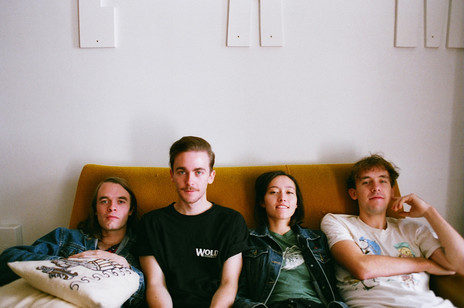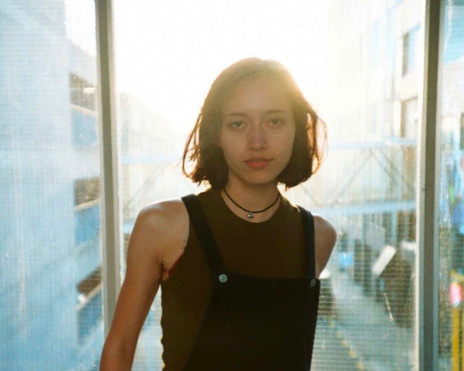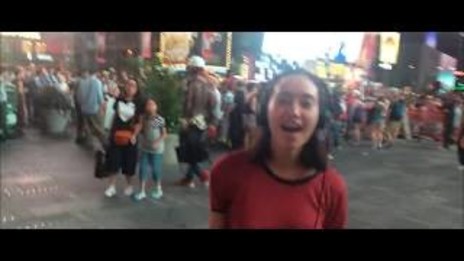AudioCulture
The noisy library of New Zealand music
Te pātaka korihi o ngā puoro o Aotearoa
Fazerdaze
Amelia grew up with a Pākēha father and Indonesian mother on the outskirts of Wellington. They arranged piano lessons for her as a nine-year-old and she took part in competitions, but found her teacher less than supportive, which led her to quit. A few years later, she was watching television when she had the sudden impulse to pick up the electric guitar lying in the corner that her father had bought for her brother. She knew that somehow she had to learn how to play it.
Her friends mainly listened to the classic hits of The Beatles, Bob Dylan, Led Zeppelin, and Carole King, so she started out by learning the chords to some basic Beatles songs. When her parents divorced, her school grades dropped and her time spent playing guitar increased exponentially. She had been playing tennis representing Wellington, but even her tennis coach saw the way things were going – giving her a Smashing Pumpkins compilation CD shortly before she quit the team.
Amelia struggled to find a regular social circle in her early years at Onslow College. She eventually found a close-knit group of friends and a band all at the same time, when she formed The Tangle with bassist Kasia Venter, guitarist Rachael Visser, keyboardist Lana Wagner and drummer Danielle Tod.
The Tangle entered the Smokefree Rockquest, but didn’t get past the Wellington Regional Final. Unperturbed, they played a fundraising show for the SPCA in their school hall and headlined a show at all-ages venue Zeal. In the audience at Zeal were budding musicians Gussie Larkin and Lily West, who were blown away. Larkin later said it planted the seed of them starting their own group, Mermaidens.
The Tangle got as far as self-releasing an EP, Where the Road Goes, but when high school ended, so did The Tangle – and Amelia fell into a rut. She took a year off, then headed north to undertake a BMus at Auckland University.
Going solo as Fazerdaze
Living as a student meant finding cheap rental accommodation in tiny, horrible rooms. She nonetheless began trying to record her own music, using a basic set up: a cheap USB mic bought from Dick Smith and her laptop. She took a course on sound recording near the end of her BMus and forced herself to make sense of the technical aspects of the lessons, which slowly made more sense as she tried to apply them to her home recordings.
She did her best to find footholds in the local music scene where she could. This led to a part-time job as associate editor at NZ Musician magazine, which gave her some insight into how musicians approached their work and how to publicise it. Eventually she gained enough confidence to start doing her own solo shows, using a loop pedal to live-record the main riffs of a song then singing and playing guitar over the layered parts.
Working at
‘NZ Musician’ magazine gave MURRAY some insight into how musicians approached their work
Amelia recalls her accidental breakthrough. “I played an open mic night at Juice Bar in Parnell. I didn’t realise it was a competition but I ended up winning a hundred dollars and the chance to play at the Juice TV Naked sessions, where I opened for Goodshirt.”
Fazerdaze’s first single ‘Reel’ got around the limitations of her tiny home recording space by adding thick reverb and a hint of distortion to the voice and guitar, while pushing the MIDI drums up high in the mix. It was lo-fi, but her ghostly vocals were reminiscent of classic shoegaze (My Bloody Valentine, Ride), the wispiness making the melodies all the more haunting. Radio DJ Charlotte Ryan liked it so much, she invited Amelia up to be interviewed on her show on Kiwi FM and Fazerdaze began to have a run of student radio hits.
Fazerdaze expanded to a three piece, with Gareth Thomas (Goodshirt) on bass and Andrea Holmes (Fang, Sleeper’s Union) on drums, though her live sets continued to include a solo section with the loop pedal. In October 2014, Fazerdaze set off on a national tour supporting Clap Clap Riot, so Amelia hurriedly finished the six songs she’d been recording in her bedroom and did a run of CDs, enlisting her flatmates to help sew covers for them. The songs were given a final mix by Jonathan Pearce (The Beths), who worked with her to smooth away some of the rougher edges.
The self-titled EP surprised her by selling a couple of hundred copies, just via her live shows or posted out from her house. Songs from the EP gradually picked up interest from blogs overseas, but not enough to hint at the wild online popularity that lay ahead.
International interest yields viral success
In early 2015, Fazerdaze went overseas for the first time, playing a handful of shows in Melbourne. The band was also busy on the home front, touring often (most notably supporting Unknown Mortal Orchestra) and making its first festival appearances at Other’s Way and the McLaren Valley Music & Arts festival. The band line-up expanded to include guitarist/keyboardist Mark Perkins, who had his own group Merk, which Amelia would sometimes join on bass.
A sign of Fazerdaze’s growing reputation was that they were asked to cover Marlon Williams’ ‘Dark Child’ at the APRA Silver Scroll Awards. However it was the following year when things really got going. The growing demand for them as a live act eventually became too much for Thomas and Holmes, so Amelia created a new line-up with Perkins, drummer Elliot Francis and Benjamin Locke (ex-Sea Views and solo artist, who would later become a member of Phoebe Rings).
One early highlight in 2016 was supporting Liam Finn, Connan Mockasin, and Lawrence Arabia at the Crystal Palace theatre – a show which also included surprise guests Bic Runga and Mick Fleetwood.
Fazerdaze’s next single ‘Little Uneasy’ had a breezy indie-pop sound which belied the melancholy of the lyrics, while the slightly off-centre drums kept things interesting. It was also matched by a perfectly matched video, which saw Amelia on a long skateboard, drifting through empty suburban streets.
‘Little Uneasy’ had a breezy indie-pop sound and a video of MURRAY SKATING through empty suburban streets
Fazerdaze headed to the UK for a series of shows in June, supporting British band Big Deal. The overseas push then continued with a return visit to Australia. This included a slot at the Big Sound industry event, where Amelia met up with someone she’d been emailing for a while – Ashley Sambrooks, who ran music publicity company Higher Plains. He signed on as her manager, bringing with him a worldwide set of connections.
Also in the audience at The Big Sound conference were some of Spotify’s local staff and they were so taken by her performance of ‘Jennifer’ off the first EP that they immediately added it to the popular Indie Mixtape playlist. It was a sparse song that was held together by a repeating guitar riff and softly strummed guitar, which meant Amelia’s fine singing voice could be heard more clearly than the other EP tracks. The song took off, though Amelia was already on to the next challenge: playing a couple of impromptu solo shows in New York.
“Flying Nun organised one of the gigs in New York for me, the other was organised by a fan. I was working for Ben Howe at the Flying Out record store at the time and Ben just happened to be in New York while I was over there on a trip to check out the music scene and see some friends.”
In October, Amelia attended the Red Bull Academy in Montreal, which was made all the better by the fact her friend Merk was also accepted to be a participant that year. Björk was one of the speakers, though she also did a DJ set at the event and sat down with the participants for lunch. Despite the surrealness of it, the event gave Amelia a real sense of becoming part of the worldwide music scene.
In 2017, Fazerdaze had a new breakthrough. The new single ‘Lucky Girl’ had been written in one of Amelia’s cheap student flats, in which her room had only a skylight instead of windows, but became so hot with the sun beating through it in summer that she often had to cover it and live in the stuffy near-dark. She responded by writing a song about the things that were going well in her life, creating a love song about trying not to let negative thoughts stop the flowering of a new relationship.
The song was paired with a video that combined views of nature with artfully framed shots of Amelia singing, standing against a blue sky, and falling onto grass (all shot on luscious 16mm film). Her existing fans gave the video a solid start on YouTube and then it ran ahead of all expectations, with the combined streams/views going from millions to tens of millions.
It was perfect timing given that her debut album Morningside (2017) was just being released through Flying Nun (who’d also picked up her EP). The title referred to a flat that she lived in with Gareth Thomas in the inner city suburb of Morningside. It was here that she’d finally found a secure home for setting up her home studio and also the headspace to complete a longer body of work. Thomas also had his own studio there, so Amelia could pop in to add vocals to his tracks or get him to record bass on one of hers (some also included their former bandmate, Andrea Holmes).
Their place also happened to be near to the house of Thomas’s Goodshirt bandmate Murray Fisher, who had agreed to help mix the record. He was a great fit, since he was open to giving advice without ever trying to override her own vision for the project.
Fazerdaze promoted the album by undertaking a massive world tour that included months of shows across the UK, Europe, Canada, and the US. There was also a jaunt through South East Asia, which took Amelia to Japan, Hong Kong, Taiwan, Malaysia, Singapore and her mother’s home country of Indonesia. All this touring meant her core band was sometimes unavailable, so Amelia brought new band members in: Guy Cowan, Benjamin Tindall, and Oliver O’Loughlin.
In 2018, Fazerdaze reached a new level of success when they were given a slot at Coachella in the US and a side-show nearby supporting Haim. More headlining shows and festival slots were booked for the UK and Europe, but Amelia was feeling overwhelmed and decided to pull the plug. Fazerdaze went into hibernation and it would be five years before a follow-up to Morningside finally came out.
The return
Fazerdaze’s only new work to appear over the next few years were low-key appearances on other people’s tracks that she’d recorded previously – ‘First Nail In The Coffin’ by Aporia, ‘Gold in the Tide’ by Sparrows, and ‘Window Eyes’ by Eyedress. In 2019, Fazerdaze appeared for a rare show supporting Mac Demarco in Auckland and then played NestFest in Hawke’s Bay.
Fans got their best chance to hear Amelia’s voice on the song she did with Phoenix Foundation, ‘Beside Yourself’. While it was a wonderful slice of upbeat indie pop, the song went largely under the radar as a standalone single without much push behind it.
Murray provided an explanation of her years of inactivity in a short documentary, ‘The Thick of It’
Then, finally, in July 2022, Fazerdaze at last reappeared. Firstly, there was the single ‘Come Apart’, which was a great, quiet-loud, fuzzed-up song about a relationship break-up. Amelia had always been one to put her heart on her sleeve in her music and so she decided to provide a fuller explanation of her years of inactivity by releasing a short documentary, The Thick of It (filmed by Joey Clough), in which she described hard years full of self-doubt and the heart-breaking end of a long-term relationship.
The documentary was interspersed with new music Amelia had made and Clough filmed videos for ‘Come Apart’ and the follow-up single ‘Break!’ which came from a six-song EP of the same name (though one song was originally held back from digital release). It didn’t take long before the EP had garnered millions of streams and Fazerdaze kicked off a new run of shows in Aotearoa and beyond. Amelia also paid back her friend Murray Fisher for his help on her album by co-writing and duetting on a song, ‘Magic’ by his band, Voom (who she’d also played early shows with).
Fazerdaze started 2023 by supporting Lorde for a series of Arena shows throughout Aotearoa. Joining Amelia in the band were guitarist Dave Rowlands (Clap Clap Riot), keyboardist Carla Camilleri (Recitals), bassist Kat Tomacruz, and drummer Oliver O’Loughlin.
Amelia Murray had found a new way forward and could now look back over Fazerdaze’s lost years as being an essential period of growth for her own well-being:
“I was putting my dreams ahead of my health. I was putting Fazerdaze ahead of Amelia. It has to be the other way around. I just had to grow up and be an adult and let go of my dreams. To be like – ‘bye, I’m looking after myself.’ When I started looking after me, that’s when everything came back.”
--
Update by Gareth Shute, 13 December 2024
Murray first read the phrase “soft power” in Michelle Obama’s autobiography and it resonated with her. As she moved into recording her next album, Soft Power (2024), she tried to bring a new forcefulness to her sound. She told RNZ:
“I think I’m getting more bold and experimental at some point on the record. Just a bit more fierceness, which I don’t think I had on the Morningside album. The Break! EP just bridged me into getting a bit more of my fierceness back. Also I think on Soft Power, sonically, I was trying to get this power in the kick, the drums, and the bass, but also have this softness in synths, this dreaminess. To balance the oomph with this prettiness.”
Murray acted as producer on the album and pushed into new areas across the 11 tracks – from the catchy synths riffs of the title track written by Shannon Fowler (Tom Lark) to the near rapped chorus of ‘A Thousand Years’ through to the surprisingly poppy chorus of ‘So Easy’ (co-written with Buzz Moller from Voom and Gareth Thomas). However, the standout track was ‘Cherry Pie’, which perfectly combined punchy drums with a wash of emotive synth chords. Surprisingly, the LA-based, New Zealand pop producer Leroy Clampitt had a hand in the track; it was the only tangible result from a songwriting trip to LA that had instead taught Murray that working largely on her own was the best way to gain the results she was after.
The album was promoted with a tour of the US and Australia, which saw Murray either playing with US session musicians or, more often, performing as a duo with Dave Rowlands (Clap Clap Riot). Seven years earlier, she’d made a DIY music video for her song ‘Bedroom Talks’ by having Mark Perkins film her on his phone while walking through Times Square in New York. Now a massive digital billboard over the square showed a Spotify ad with her photo and artist name. There was no question: Fazerdaze was back.
On 29 May 2025, Soft Power was named NZ On Air Te Tino Pukaemi o te Tau | Album of the Year at the Aotearoa Music Awards 2025.


















Visit our sister site
NZ On ScreenMade with funding from
NZ On Air




